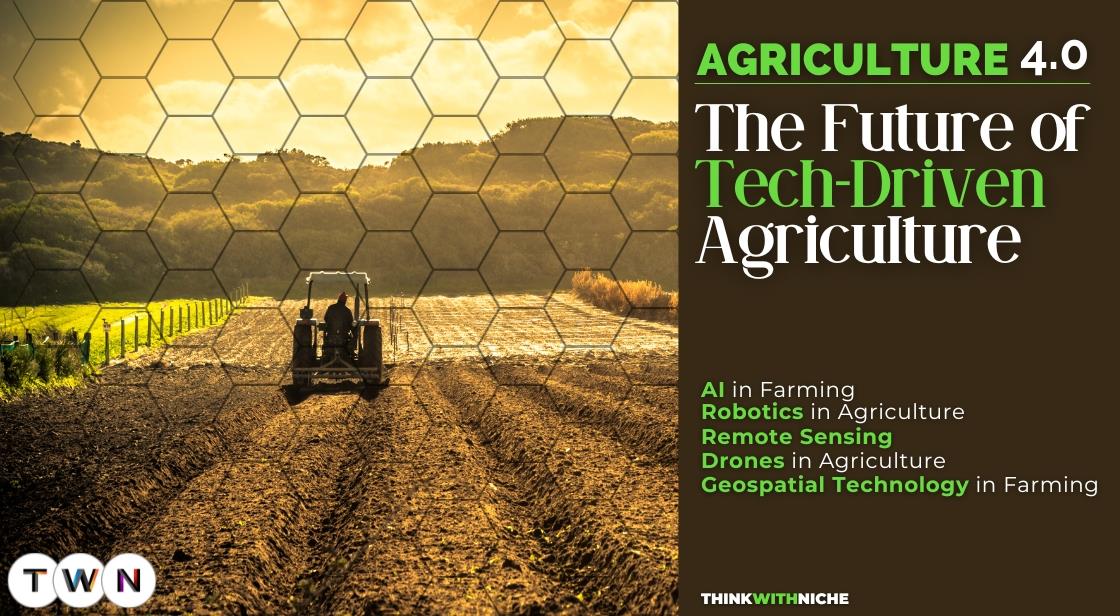Agriculture 4.0: The Future of Tech-Driven Agriculture

Blog Post
In today's ever-evolving world, agriculture is experiencing a profound transformation that is reshaping the future of farming. Termed "Agriculture 4.0," this new era of agriculture is characterized by its reliance on cutting-edge technology to revolutionize the way we produce food.
Agriculture 4.0 harnesses the power of digital agriculture, smart farming, and advanced technologies to enhance agricultural productivity, sustainability, and efficiency.
The global Agriculture 4.0 market is on a rapid ascent and is projected to reach an impressive $15 billion by 2027. The driving force behind this growth is the pressing need to meet the demands of a growing global population while simultaneously reducing the environmental impact of agricultural practices.
In this comprehensive exploration of Agriculture 4.0, we delve into the core technologies and innovations that are reshaping the agricultural landscape.
From precision farming software and artificial intelligence (AI) to robotics, remote sensing, and the use of drones, we uncover how each facet of Agriculture 4.0 is contributing to increased crop yields, reduced input costs, improved sustainability, and enhanced food safety.
While the benefits of Agriculture 4.0 are abundant, we also acknowledge the challenges it faces, including cost barriers, accessibility issues, the need for skill development among farmers, and concerns surrounding data privacy and security.
Despite these challenges, the future of Agriculture 4.0 holds great promise. As technology continues to advance and become more accessible, Agriculture 4.0 is set to transform farming practices globally.
With a commitment to research and development, we can pave the way for a more sustainable, equitable, and tech-driven future for agriculture. Join us on this journey into the exciting realm of Agriculture 4.0, where innovation meets the earth to feed a growing world population sustainably.
In the ever-evolving landscape of agriculture, a new era is dawning, and it goes by the name of Agriculture 4.0. This forward-looking paradigm shift in farming is propelled by the relentless march of technology, reshaping the way we cultivate our fields and nurture our crops.
Agriculture 4.0 emerges as a beacon of hope, enabling farmers to achieve greater yields with fewer resources while simultaneously treading lightly on the environment. The grandeur of this transformation extends globally, with the Agriculture 4.0 market projected to burgeon to a staggering $15 billion by the year 2027.
This meteoric rise is underpinned by an unassailable imperative: the urgent need to augment food production while curbing the environmental footprint of agriculture.
A report by EMR (Emergen Research) paints an illuminating picture of the Indian agricultural landscape. The Indian agriculture market, valued at $435.9 billion in 2022, is slated to ascend to $580.8 billion by 2028. This remarkable growth trajectory is attributed to several factors, including an escalating demand for food, the escalating costs of agricultural inputs, and the ever-widening embrace of technology.
In India, the dawn of Agriculture 4.0 is imminent. The government of India is fervently championing the adoption of these cutting-edge technologies through various initiatives, with the National Mission for Sustainable Agriculture at the forefront.
Join us on a captivating journey into the heart of Agriculture 4.0, where technology and tradition converge to pave the way for a more sustainable, productive, and environmentally conscious future in farming.
Agriculture 4.0: The Future of Tech-Driven Agriculture
What is Agriculture 4.0?
Agriculture 4.0 is the next generation of farming, also known as digital agriculture or smart farming. It is a holistic approach to agriculture that leverages cutting-edge technologies to improve agricultural productivity, sustainability, and efficiency. Agriculture 4.0 is driven by the convergence of artificial intelligence (AI), robotics, big data, and the Internet of Things (IoT).
Agriculture 4.0 technologies are used to collect and analyze data from farms in real time, which allows farmers to make more informed decisions about crop management, irrigation, pest control, and other aspects of farming. This can lead to significant increases in crop yields, reductions in input costs, and improved environmental sustainability.
Key Technologies in Agriculture 4.0
Precision farming software-as-a-service (SaaS)
Precision farming software-as-a-service (SaaS) is a cloud-based software solution that helps farmers to make more informed decisions about crop management. It does this by providing farmers with access to real-time data about their crops and soil conditions. This data can be used to optimize irrigation, fertilization, and pesticide application, and to identify and address crop problems early on.
The rapid expansion of the precision farming Software-as-a-Service (SaaS) sector in India can be attributed to various contributing factors, such as:
-
The increasing demand for food: India's population is growing rapidly, and this is putting increasing pressure on the country's food supply. Precision farming can help farmers to produce more food on less land.
-
The rising cost of inputs: The cost of agricultural inputs such as fertilizer and pesticides is rising. Precision farming can help farmers to reduce their input costs by using them more efficiently.
-
The increasing availability of technology: Precision farming technologies are becoming more affordable and accessible to Indian farmers.
Precision farming SaaS offers a number of benefits to farmers, including:
-
Increased crop yields: Precision farming can help farmers to increase their crop yields by up to 20%.
-
Reduced input costs: Precision farming can help farmers to reduce their input costs by up to 30%.
-
Improved environmental sustainability: Precision farming can help farmers to reduce their environmental impact by reducing their use of water, fertilizer, and pesticides.
-
Enhanced food safety: Precision farming can help farmers to improve the safety of their food by tracking crops from farm to fork.
Here are some specific examples of how precision farming SaaS is being used in India:
-
Farmers are using precision farming SaaS to create precision agriculture maps. These maps can be used to apply inputs such as fertilizer and water more precisely to crops, which can help to reduce costs and improve environmental sustainability.
-
Farmers are using precision farming SaaS to monitor crop health and identify pests and diseases. For example, farmers can use precision farming SaaS to identify areas of their fields that are stressed or diseased. This information can help them to take early action to address the problem.
-
Farmers are using precision farming SaaS to manage irrigation systems. For example, farmers can use precision farming SaaS to determine the optimal time and amount of water to apply to their crops. This can help to improve water use efficiency and reduce costs.
Additional points:
-
Precision farming SaaS is a relatively new market in India, but it is growing rapidly.
-
There are a number of Indian and international companies that offer precision farming SaaS solutions.
-
The Indian government is supporting the adoption of precision farming technologies through a number of initiatives, such as the National Mission for Sustainable Agriculture.
Use of Artificial intelligence (AI) in farming
AI is used to develop algorithms that can analyze large amounts of data and make predictions about crop yields, pests, and diseases.
Artificial intelligence (AI) is being used to revolutionize agriculture in a number of ways, including:
Crop yield prediction: AI algorithms can be used to analyze historical crop data and weather data to predict crop yields for the upcoming season. This information can help farmers to make better decisions about planting, irrigation, and fertilization.
Pest and disease detection: AI can be used to analyze images of crops to identify signs of stress, disease, or pests. This information can help farmers to take early action to address the problem.
Precision agriculture: AI can be used to develop precision agriculture maps, which can help farmers to apply inputs such as fertilizer and water more precisely to crops. This can help to reduce costs and improve environmental sustainability.
Irrigation optimization: AI can be used to determine the optimal time and amount of water to apply to crops, based on factors such as soil moisture levels, weather conditions, and crop growth stage. This can help to improve water use efficiency and reduce costs.
New crop varieties: AI could be used to develop new crop varieties that are more resistant to pests and diseases, and that are better adapted to changing climate conditions.
New farming practices: AI could be used to develop new farming practices that are more sustainable and environmentally friendly. For example, AI could be used to develop more efficient ways to use water and fertilizer, and to reduce the use of pesticides.
New products and services: AI could be used to create new agricultural products and services that meet the needs of consumers. For example, AI could be used to develop new ways to track food from farm to fork, and to ensure food safety.
Here are some examples of how AI is already being used in agriculture today:
-
Farmers in California are using AI to monitor their crops for signs of stress and disease.
-
Farmers in India are using AI to develop precision agriculture maps.
-
Researchers at the University of California, Davis are using AI to develop new crop varieties that are more resistant to pests and diseases.
AI is still a relatively new technology in agriculture, but it has the potential to revolutionize the way that we produce food. By using AI to improve agricultural productivity, sustainability, and efficiency, we can help to feed a growing population in a sustainable way.
Use of Robotics in Agriculture
Robotics is playing an increasingly important role in agriculture. Autonomous machines are being developed to perform a variety of tasks, including:
-
Planting: Robotic planters can plant seeds accurately and evenly, which can help to improve crop yields.
-
Weeding: Robotic weeders can identify and remove weeds from fields, which can help to reduce the use of herbicides.
-
Harvesting: Robotic harvesters can pick fruits and vegetables quickly and efficiently, which can help to reduce labor costs and reduce food waste.
-
Milking: Robotic milking machines can milk cows automatically, which can free up farmers to focus on other tasks.
-
Monitoring: Robotic drones and sensors can be used to monitor crops and livestock, providing farmers with valuable data about their operations.
Here are some specific examples of how robotics is being used in agriculture today:
-
Farmers in California are using robotic planters to plant their crops. This has helped them to improve their crop yields and reduce their labor costs.
-
Farmers in Australia are using robotic weeders to remove weeds from their fields. This has helped them to reduce their use of herbicides and improve the environmental sustainability of their operations.
-
Farmers in the Netherlands are using robotic harvesters to pick strawberries. This has helped them to reduce their labor costs and reduce food waste.
-
Farmers in the United States are using robotic milking machines to milk their cows. This has freed up farmers to focus on other tasks, such as managing their businesses and caring for their livestock.
Here are some of the benefits of using robotics in agriculture:
-
Increased productivity: Robotic machines can work 24/7, which can help farmers to increase their crop yields.
-
Reduced labor costs: Robotics can automate tasks that are currently performed by humans, which can help farmers to reduce their labor costs.
-
Improved environmental sustainability: Robotics can help farmers to reduce their use of pesticides and herbicides, and to improve the efficiency of their water and fertilizer use.
-
Enhanced food safety: Robotics can help farmers to ensure the safety of their food by tracking crops from farm to fork.
Also Read: The Role of FinTech in Promoting Biodiversity Conservation
Remote sensing in Agriculture
Remote sensing is a rapidly evolving field that is playing an increasingly important role in agriculture. It uses satellites, drones, and other sensors to collect data about crops and soil from a distance. This data can be used to monitor crop health, identify pests and diseases, and estimate yields.
Latest facts and updates on remote sensing in agriculture:
-
Remote sensing is becoming more accurate and affordable. Advances in technology have led to the development of new sensors that can collect more detailed and precise data about crops and soil. Additionally, the cost of remote sensing technologies has decreased, making them more accessible to farmers of all sizes.
-
Remote sensing is being used to develop new agricultural practices. For example, farmers are using remote sensing data to implement precision agriculture practices, which involve applying inputs such as fertilizer and water more precisely to crops. This can help to reduce costs and improve environmental sustainability.
-
Remote sensing is being used to monitor and manage agricultural risks. For example, farmers are using remote sensing data to track the spread of pests and diseases, and to predict crop yields. This information can help farmers to take steps to mitigate risks and protect their crops.
Here are some specific examples of how remote sensing is being used in agriculture:
-
Satellite imagery is being used to monitor crop health and identify pests and diseases. For example, farmers can use satellite imagery to identify areas of their fields that are stressed or diseased. This information can help them to take early action to address the problem.
-
Drones are being used to collect high-resolution images of crops. This data can be used to assess crop health, estimate yields, and identify pests and diseases.
-
Ground-based sensors are being used to collect data about soil moisture and nutrient levels. This information can help farmers to make more informed decisions about irrigation and fertilization.
Use of Drones in Agriculture
Drones are unmanned aerial vehicles (UAVs) that are revolutionizing the agricultural industry. They are equipped with cameras, sensors, and other tools that can be used for a variety of tasks, including:
-
Crop monitoring: Drones can be used to monitor crop health, growth patterns, and potential problem areas. This information can help farmers to identify and address issues early on, before they cause significant damage.
-
Aerial surveys: Drones can be used to conduct aerial surveys of fields, which can provide farmers with valuable information about their crops and soil. This information can be used to make better decisions about irrigation, fertilization, and other crop management practices.
-
Pest and disease control: Drones can be used to spray pesticides and herbicides on crops. This can help farmers to control pests and diseases more effectively and efficiently than traditional methods.
-
Data collection: Drones can be used to collect data about crops and soil, such as soil moisture levels, nutrient levels, and crop yields. This data can be used to improve crop management practices and increase productivity.
Here are some specific examples of how drones are being used in agriculture today:
-
Farmers are using drones to monitor crop health. Drones can be equipped with cameras that can detect signs of stress, disease, and pests in crops. This information can help farmers to take early action to address the problem and prevent crop losses.
-
Farmers are using drones to conduct aerial surveys of their fields. This data can be used to create detailed maps of fields, which can help farmers to identify areas that need more or less irrigation, fertilization, or other inputs.
-
Farmers are using drones to spray pesticides and herbicides on crops. This can help farmers to control pests and diseases more effectively and efficiently than traditional methods.
-
Farmers are using drones to collect data about their crops and soil. This data can be used to improve crop management practices and increase productivity.
Use of Geospatial technology in farming
Geospatial technology is a broad term that encompasses a variety of tools and techniques for collecting, analyzing, and visualizing spatial data. Spatial data is data that has a geographic reference, such as GPS coordinates. Geospatial technology is used in a wide range of industries, including agriculture.
In agriculture, geospatial technology can be used for a variety of purposes, including:
-
Mapping: Geospatial technology can be used to create detailed maps of farms and fields. These maps can be used to identify the different types of soil on a farm, as well as the location of crops, irrigation systems, and other features.
-
Data analysis: Geospatial technology can be used to analyze spatial data to identify patterns and trends. For example, farmers can use geospatial technology to identify areas of their fields that are more productive than others, or areas that are more susceptible to pests and diseases.
-
Decision support: Geospatial technology can be used to develop decision support systems that help farmers make better decisions about crop management. For example, farmers can use geospatial technology to determine the optimal time to irrigate their crops or to apply fertilizer.
Here are some specific examples of how geospatial technology is being used in farming today:
-
Farmers are using geospatial technology to create precision agriculture maps. These maps can be used to apply inputs such as fertilizer and water more precisely to crops, which can help to reduce costs and improve environmental sustainability.
-
Farmers are using geospatial technology to monitor crop health and identify pests and diseases. For example, farmers can use geospatial technology to identify areas of their fields that are stressed or diseased. This information can help them to take early action to address the problem.
-
Farmers are using geospatial technology to manage irrigation systems. For example, farmers can use geospatial technology to determine the optimal time and amount of water to apply to their crops. This can help to improve water use efficiency and reduce costs.
Benefits of Agriculture 4.0
Agriculture 4.0 offers a number of benefits, including:
Increased crop yields
Agriculture 4.0 technologies can help farmers to increase their crop yields in a number of ways. For example, precision agriculture technologies such as GPS-guided tractors and variable-rate fertilizer applicators can help farmers to apply the right amount of inputs to the right place at the right time. This can help to reduce waste and improve crop yields.
In addition, technologies such as remote sensing and drones can be used to monitor crop health and identify pests and diseases early on. This allows farmers to take early action to address problems, which can help to prevent crop losses.
Reduced input costs
Agriculture 4.0 technologies can also help farmers to reduce their input costs. For example, precision agriculture technologies can help farmers to apply the right amount of inputs, which can reduce waste. Additionally, technologies such as remote sensing and drones can help farmers to identify areas of their fields that are less productive, which can allow them to reduce their input use in those areas.
Improved sustainability
Agriculture 4.0 technologies can also help farmers to improve the sustainability of their operations. For example, precision agriculture technologies can help farmers to reduce their use of water and fertilizer, which can reduce their environmental impact. Additionally, technologies such as remote sensing and drones can help farmers to monitor crop health and identify pests and diseases early on, which can help them to reduce their use of pesticides.
Enhanced food safety
Agriculture 4.0 technologies can also help farmers to improve the safety of their food. For example, technologies such as blockchain can be used to track crops from farm to fork, which can help to identify and eliminate contaminated food. Additionally, technologies such as remote sensing and drones can be used to monitor crop health and identify pests and diseases early on, which can help farmers to prevent food contamination.
Overall benefits of Agriculture 4.0
Agriculture 4.0 is a transformative approach to agriculture that has the potential to revolutionize the way that we produce food. By using cutting-edge technologies to improve agricultural productivity, sustainability, and efficiency, Agriculture 4.0 can help us to feed a growing population in a sustainable way.
Here are some additional benefits of Agriculture 4.0:
-
Improved working conditions for farmers: Agriculture 4.0 technologies can help to improve working conditions for farmers by automating tasks and reducing the need for manual labor.
-
Increased access to food: Agriculture 4.0 technologies can help to increase access to food by making it possible to produce more food on less land.
-
Reduced food waste: Agriculture 4.0 technologies can help to reduce food waste by improving the efficiency of the food supply chain.
Agriculture 4.0 is still in its early stages of development, but it has the potential to transform agriculture in many ways. As Agriculture 4.0 technologies continue to develop and become more accessible, we can expect to see even more innovative and effective applications of Agriculture 4.0 in the future.
Challenges of Agriculture 4.0
Agriculture 4.0 also faces a number of challenges, including:
-
Cost: Agriculture 4.0 technologies can be expensive to implement.
-
Access: Agriculture 4.0 technologies may not be accessible to all farmers, especially smallholder farmers in developing countries.
-
Skill development: Farmers need to develop new skills in order to use Agriculture 4.0 technologies effectively.
-
Data privacy and security: Agriculture 4.0 technologies collect a lot of data, which raises concerns about data privacy and security.
The future of Agriculture 4.0
Agriculture 4.0 is still in its early stages of development, but it has the potential to revolutionize the way that we produce food. As Agriculture 4.0 technologies become more affordable and accessible, we can expect to see them adopted by more and more farmers around the world.
Agriculture 4.0 has the potential to help us to feed a growing population in a sustainable way. It can also help us to reduce the environmental impact of agriculture. By investing in Agriculture 4.0 research and development, we can create a more sustainable and equitable future for agriculture.
You May Like
EDITOR’S CHOICE












